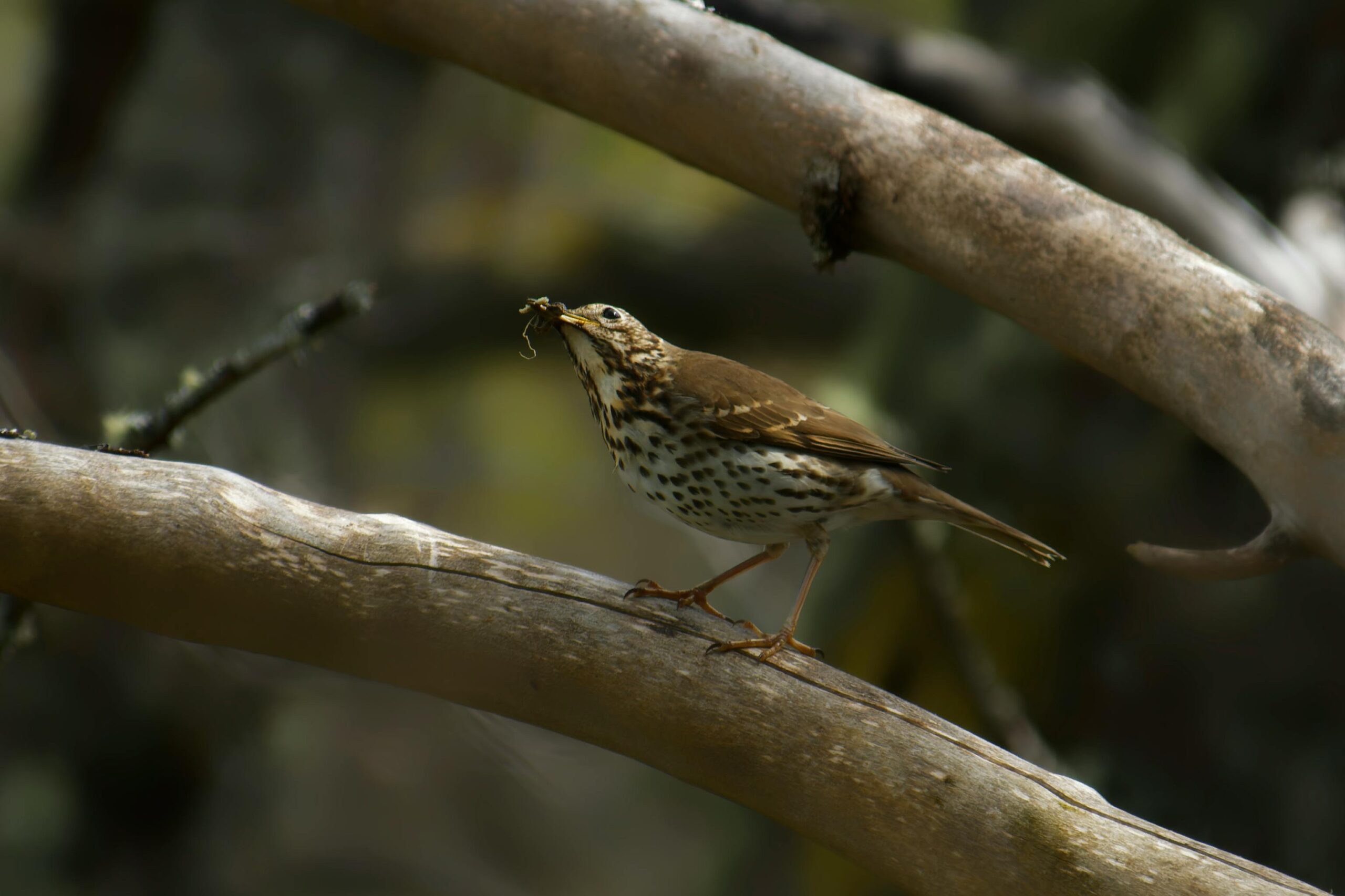The song thrush (Turdus philomelos) is a small, melodious bird renowned for its enchanting song and distinctive speckled breast. Found across Europe, Asia, and parts of North Africa, the song thrush is a symbol of natural beauty and biodiversity. With its wide-ranging habitat preferences and unique behavior, this species has captivated bird enthusiasts and researchers alike.
However, in recent years, the song thrush has faced challenges such as habitat loss, predation, and environmental changes, raising concerns about its conservation status. This article delves into the life of the song thrush, exploring its habitat, physical characteristics, feeding habits, vocal communication, and the ongoing efforts to ensure its survival.
Habitat and Distribution of the Song Thrush
The song thrush is an adaptable bird species with a widespread distribution. It can be found in a variety of habitats ranging from temperate forests and woodlands to gardens and urban parks. This flexibility allows the species to thrive in both natural and human-altered environments, provided suitable nesting sites and food sources are available.
Primarily a resident bird in much of its range, the song thrush does exhibit some migratory behavior, particularly in northern populations. During the colder months, individuals from these regions often migrate southwards to escape harsh winters, reaching as far as North Africa and the Middle East. This migratory pattern highlights the species’ ability to adapt to diverse climatic conditions while ensuring access to resources year-round.
Common Regions Where Song Thrushes Thrive
The song thrush is native to Europe, North Africa, and parts of Asia, with the densest populations found in countries like the United Kingdom, Germany, and France. In these regions, the bird inhabits woodlands, orchards, and hedgerows, taking advantage of the dense vegetation for nesting and foraging.
Beyond its native range, the song thrush has also been introduced to other parts of the world, such as New Zealand and Australia, where it has established populations. Its success in these regions can be attributed to its adaptability and ability to exploit new ecosystems effectively.
Key factors that determine the presence of song thrushes include:
- Availability of dense shrubs or trees for nesting.
- Proximity to moist areas where they can forage for earthworms and other invertebrates.
- Access to fruit-bearing plants for sustenance, particularly during the winter months.
Physical Characteristics of the Song Thrush
The song thrush is a medium-sized bird, easily recognized by its striking plumage and elegant posture. Measuring approximately 20–23 cm (8–9 inches) in length and weighing around 50–80 grams, this bird combines beauty with agility, making it a delight for birdwatchers.
Its plumage is predominantly brown on the back and wings, with a lighter, creamy underside adorned with dark brown, heart-shaped spots. These distinctive markings not only help with identification but also provide camouflage in wooded environments, allowing the bird to blend seamlessly with its surroundings.
Both male and female song thrushes share similar physical features, although juveniles tend to have slightly more muted colors. The bird’s legs are slender and pale pink, while its bill is sharp and adapted for foraging a variety of foods, including insects and fruits.
Unique Features That Differentiate Song Thrushes
The song thrush possesses several unique characteristics that distinguish it from other thrush species:
- Speckled Chest: The bold, heart-shaped spots on its breast are a hallmark feature, easily separating it from other birds like the mistle thrush, which has more irregular markings.
- Melodious Song: Known for its repetitive, flute-like calls, the song thrush’s vocal range is far superior to most birds in its family. Each note is repeated two or three times, creating a unique, rhythmic melody.
- Wing Shape: Its rounded wings, combined with a relatively short tail, are perfectly adapted for agile flights through dense foliage.
- Behavioral Posture: The song thrush often tilts its head to the side when searching for prey on the ground, a behavior that enhances its visual acuity.
These physical traits not only make the song thrush visually appealing but also play a critical role in its survival and adaptability.
Diet and Feeding Habits of the Song Thrush
The song thrush is an omnivorous bird with a varied diet that changes with the seasons. This dietary flexibility allows it to thrive in diverse habitats and climates. Earthworms, snails, and insects make up the majority of its diet during the spring and summer months, while in the colder months, the bird relies heavily on fruits, berries, and seeds.
One of the most remarkable feeding behaviors of the song thrush is its method of cracking open snail shells. When food is scarce, the bird actively seeks out snails and uses a specific “anvil” technique: it picks up the snail and repeatedly smashes it against a hard surface, such as a rock or tree trunk, to extract the soft body inside. This behavior demonstrates not only the bird’s adaptability but also its problem-solving skills.
The song thrush is often seen foraging on the ground, hopping about in search of food. It is particularly fond of moist areas where earthworms are abundant. This reliance on soft-bodied prey also makes the bird sensitive to changes in soil conditions, as drought or pesticide use can significantly reduce food availability.
Typical Foods in a Song Thrush’s Diet
The diet of the song thrush includes:
- Insects and Invertebrates
- Earthworms
- Snails (using the anvil technique)
- Beetles and larvae
- Fruits and Berries
- Rowan berries
- Elderberries
- Wild cherries
- Fallen apples
- Seeds and Plants
- Small seeds, particularly in winter
- Shoots and other plant material when other food sources are scarce
During winter, when natural food sources may dwindle, song thrushes are known to visit gardens, feeding on windfall fruits or berries from shrubs like holly and ivy. Providing food sources such as fruit or insect-friendly gardens can help support these birds, especially in urban areas.
Song Thrush Behavior and Communication
The song thrush is a highly territorial bird, especially during the breeding season. Males establish and defend territories vigorously, often using their powerful, melodious songs as both a warning to rivals and a way to attract potential mates. This dual-purpose communication strategy is one of the most captivating aspects of their behavior.
These birds are primarily solitary, although they can sometimes be seen in small groups, especially outside the breeding season. They are active during the day and spend much of their time foraging on the ground, using their keen eyesight to locate prey.
During the breeding season, which typically runs from March to August, the song thrush builds its nest in dense shrubs or trees. The nest is a carefully constructed cup made of mud and grass, and the female lays a clutch of 4-5 eggs. Song thrushes are known for their dedication to their young, with both parents working tirelessly to feed and protect their chicks until they fledge.
The Role of Song in Social Interaction
The song of the song thrush is one of its most defining traits. Males are known for their rich, flute-like melodies, which they deliver from prominent perches, such as treetops or rooftops. Their songs are characterized by repetitive phrases, with each phrase being repeated two or three times before moving on to the next. This unique structure makes the song of the song thrush easily recognizable.
The role of their song includes:
- Attracting Mates
- Males use their complex vocalizations to demonstrate fitness and establish their suitability as a mate. Females are often drawn to the most persistent and varied singers.
- Marking Territory
- The song also serves as a territorial signal, warning other males to stay away. A male song thrush may sing for hours on end to reinforce its claim over a specific area.
- Communication with Rivals
- In cases of territorial disputes, songs can escalate to physical displays or even confrontations.
Interestingly, song thrushes are also known to mimic other birds or environmental sounds, adding to the complexity and beauty of their vocal repertoire. This mimicry not only enhances their songs but also demonstrates their adaptability and intelligence.
Conservation Status and Threats to Song Thrushes
The song thrush population has faced significant challenges over the years, with notable declines in certain regions. While still classified as a species of “Least Concern” by the International Union for Conservation of Nature (IUCN), local populations, particularly in parts of the UK and Western Europe, have experienced reductions due to a variety of environmental and human-related factors.
Key threats to the song thrush include:
- Habitat Loss:
- Urbanization, deforestation, and agricultural intensification have reduced the availability of suitable nesting and foraging habitats. Hedgerows and woodlands, crucial for breeding and feeding, have been particularly impacted.
- Use of Pesticides:
- The widespread use of chemical pesticides in farming has led to a decline in the bird’s primary food sources, such as earthworms and insects. This has directly affected their ability to find sufficient food, especially during the breeding season.
- Predation:
- Song thrushes are vulnerable to predators such as domestic cats, magpies, and other birds of prey. Nest predation is a particular issue during the breeding season.
- Climate Change:
- Changes in weather patterns and extreme weather events, such as prolonged droughts or severe winters, can impact food availability and breeding success.
Efforts to Protect the Song Thrush Population
To combat these challenges, various conservation efforts have been implemented to support the recovery of song thrush populations:
- Habitat Restoration:
- Replanting hedgerows and creating wildlife-friendly gardens have proven effective in providing song thrushes with safe nesting and feeding sites.
- Reduction of Pesticide Use:
- Advocating for organic farming practices and minimizing pesticide use have helped to restore populations of earthworms and insects, critical components of the song thrush’s diet.
- Public Awareness Campaigns:
- Educational initiatives encourage communities to provide food sources, such as fallen fruit or berry-bearing plants, during the colder months to support overwintering song thrushes.
- Research and Monitoring:
- Continued monitoring of populations and research into their behaviors and needs ensure that conservation strategies remain effective and adaptive.
While the song thrush has shown resilience and adaptability, long-term conservation efforts remain crucial to mitigate ongoing threats and ensure the survival of this beloved species.
Conclusion
The song thrush is not only a symbol of nature’s beauty but also a critical part of the ecosystem, playing a role in seed dispersal and pest control. Its melodious song and unique behaviors make it a favorite among birdwatchers and nature enthusiasts alike. However, the challenges it faces—ranging from habitat loss to climate change—underscore the importance of conservation efforts.
By protecting its habitats, reducing pesticide use, and fostering public awareness, we can help ensure the song thrush continues to thrive for future generations. The resilience of this species offers hope, but long-term vigilance is necessary to address ongoing threats. Together, we can secure a harmonious coexistence with this remarkable bird and maintain the biodiversity of our planet.

